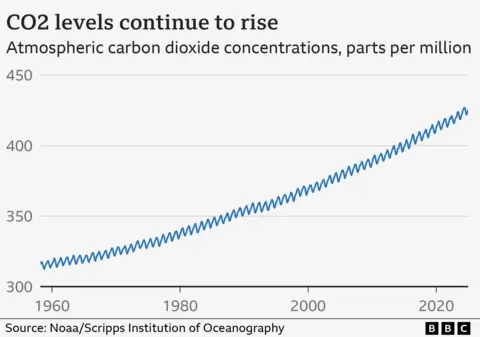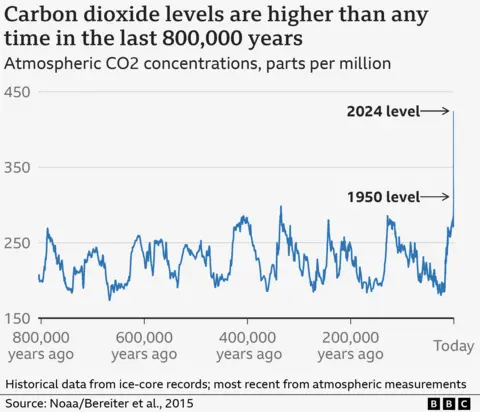
 AFP
AFPConcentrations of the most important planet-warming gas in the atmosphere rose faster than ever last year, scientists say, putting the achievement of global climate goals at risk.
Concentrations of carbon dioxide (CO2) are now more than 50% higher than before humans began burning large amounts of fossil fuels.
Fossil fuel emissions hit record highs last year, and more carbon dioxide accumulated in the atmosphere as nature struggled to absorb as much carbon dioxide due to factors such as wildfires and droughts.
The Met Office said the rapid increase in carbon dioxide emissions was “incompatible” with international commitments to limit global warming to 1.5 degrees Celsius above pre-industrial levels.
That’s the ambitious goal agreed by nearly 200 countries at a landmark United Nations conference in Paris in 2015 in hopes of averting some of the worst impacts of climate change.
Confirmed last week 2024 is the hottest year on recordwas also the first year in which the average annual temperature was 1.5 degrees Celsius above pre-industrial levels.
That doesn’t break the Paris targets, which are long-term averages over decades, but the continued rise in atmospheric carbon dioxide emissions actually forces the world to do so.
Richard Betts of the Met Office said: “Limiting global warming to 1.5 degrees Celsius would require slowing the rise in CO2 emissions, but in fact the opposite is true.”
Long-term increases in carbon dioxide are undoubtedly caused by human activity, primarily through the burning of coal, oil and gas, and deforestation.
Records of Earth’s climate in the distant past from ice cores and ocean sediments show that carbon dioxide concentrations are now at their highest levels in at least two million years, according to the United Nations.
But the increase varies from year to year due to differences in the way nature absorbs carbon and fluctuations in human emissions.

Carbon dioxide emissions from fossil fuels hit a new high last year, according to preliminary data from the Global Carbon Project team.
It also has the following effects: Natural El Niño phenomenon -Surface waters in the eastern tropical Pacific become unusually warm, affecting weather patterns.
Nature absorbs about half of humanity’s CO2 emissions, for example through additional plant growth and more of the gas dissolving in oceans.
But in the context of climate change, the extra heat from El Niño meant that natural carbon sinks on land didn’t absorb as much carbon dioxide as usual last year.
Rampant wildfires, including in areas not normally affected by El Niño, also release additional carbon dioxide.
Professor Bates said: “Even without the boost from last year’s El Niño, CO2 emissions from fossil fuel burning and deforestation would now be rising faster than the (UN climate body) IPCC’s 1.5°C scenario.”
These factors mean that the concentration of carbon dioxide in air molecules will increase by nearly 3.6 ppm between 2023 and 2024, reaching a new high of more than 424 ppm.

This is record annual growth since the first atmospheric measurements were taken in 1958 at Hawaii’s remote Mauna Loa research station. The station sits high on the side of a Pacific volcano, far from major sources of pollution, making it ideal for monitoring global carbon dioxide levels.
Professor Ralph Keeling, leader of the measurement program at Scripps Institution of Oceanography, said: “These latest results are further confirmation that as sea level rise continues to accelerate, we are entering uncharted territory at an unprecedented rate.”
 AFP
AFPThe record increase adds to concerns that nature’s ability to absorb gases that are warming the planet may diminish in the long term.
The National Oceanic and Atmospheric Administration says the Arctic tundra is turning into an overall source of carbon dioxide due to a warming climate and frequent fires.
this The Amazon rainforest’s ability to absorb carbon dioxide It has also been hit by drought, wildfires and deliberate deforestation.
Professor Bates told the BBC: “It’s an open question but one we need to keep an eye on and look at very carefully.”
The Met Office predicts that the increase in carbon dioxide concentrations in 2025 will not be as extreme as in 2024, but will still be significantly off track to achieve the 1.5 degrees Celsius target.
La Niña, in which surface water in the eastern tropical Pacific is cooler than normal, has replaced El Niño, which tends to allow nature to absorb more carbon dioxide.
Professor Bates said: “While temperatures may cool slightly, warming will resume because carbon dioxide is still building up in the atmosphere.”









